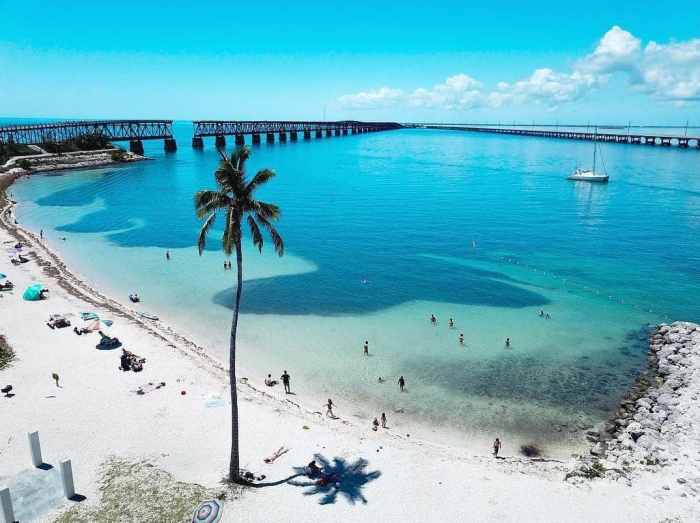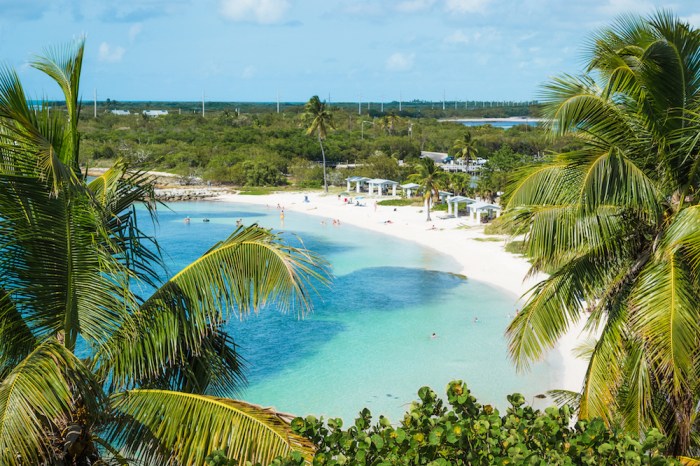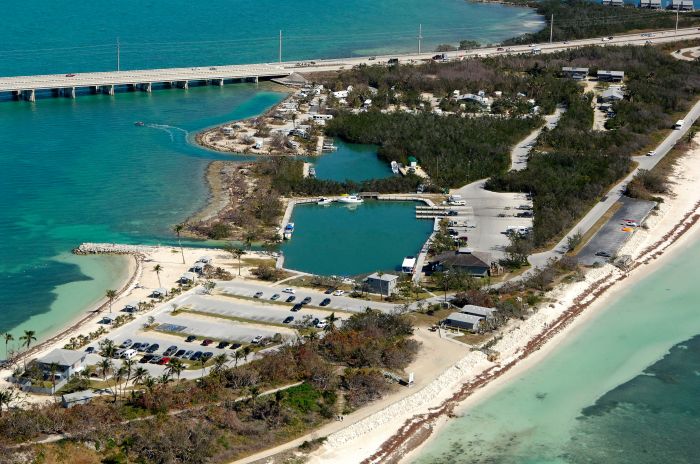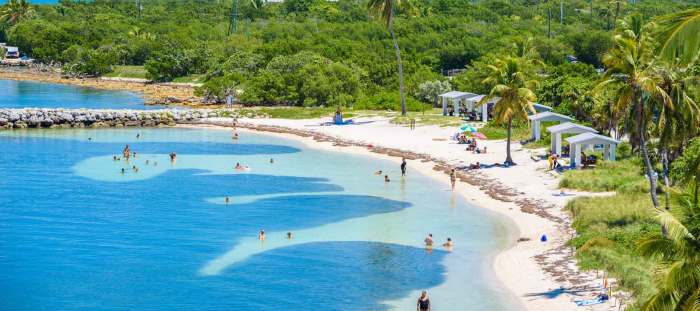Bahia Honda State Park, a breathtaking natural haven nestled in the heart of the Florida Keys, beckons travelers with its pristine beaches, vibrant marine life, and a rich tapestry of recreational opportunities.
Established in 1951, this 524-acre coastal gem boasts a captivating blend of natural wonders and cultural heritage, making it a must-visit destination for nature enthusiasts, outdoor adventurers, and history buffs alike.
Overview of Bahia Honda State Park

Bahia Honda State Park is a 524-acre (212 ha) park in the Florida Keys, United States. The park is located on Bahia Honda Key, an island approximately 35 miles (56 km) northeast of Key West. Bahia Honda State Park is known for its stunning beaches, mangroves, and coral reefs.
The park was established in 1951. It is managed by the Florida Department of Environmental Protection. Bahia Honda State Park is a popular destination for swimming, snorkeling, diving, fishing, and camping.
Natural Features, Bahia honda state park
Bahia Honda State Park is home to a variety of natural features, including:
- Beaches: The park has over two miles of sandy beaches. The beaches are perfect for swimming, sunbathing, and building sandcastles.
- Mangroves: The park is home to a large mangrove forest. The mangroves provide habitat for a variety of marine life, including fish, crabs, and birds.
- Coral reefs: The park is located near the Florida Reef Tract, the third-largest coral reef system in the world. The coral reefs are home to a variety of marine life, including fish, corals, and sea turtles.
Natural Resources and Biodiversity
Bahia Honda State Park encompasses diverse marine and terrestrial ecosystems, showcasing a rich array of flora and fauna. Its vibrant coral reefs, seagrass beds, and mangrove forests support a multitude of marine species, while the upland habitats nurture a variety of terrestrial organisms.
The park’s marine environment is home to over 500 species of fish, including snappers, groupers, and barracudas. The coral reefs, teeming with life, provide habitat for countless invertebrates, such as sponges, sea stars, and lobsters. Seagrass beds, essential for juvenile fish and invertebrates, create a vital nursery ground within the park’s waters.
Threatened and Endangered Species
Bahia Honda State Park serves as a sanctuary for several threatened and endangered species, including the American crocodile, loggerhead sea turtle, and least tern. These species face numerous challenges, including habitat loss, pollution, and climate change. The park’s conservation efforts play a crucial role in protecting these vulnerable populations.
Conservation and Habitat Protection
The park’s diverse ecosystems provide critical habitat for a wide range of species. Mangrove forests, with their intricate root systems, act as natural barriers against coastal erosion and storm surges. Seagrass beds, essential for maintaining water quality and providing shelter for marine life, also serve as a carbon sink, contributing to climate change mitigation.
Bahia Honda State Park’s commitment to conservation extends beyond its boundaries, supporting initiatives that protect the surrounding marine environment. The park collaborates with local organizations and agencies to implement restoration projects, reduce pollution, and promote sustainable practices, ensuring the long-term health of the park and its ecosystems.
Recreational Opportunities
Bahia Honda State Park offers a diverse range of recreational activities for visitors of all ages and interests. Whether you seek adventure, relaxation, or simply a chance to connect with nature, the park has something to offer.
Camping enthusiasts can choose from two campgrounds within the park, offering a total of over 100 campsites. Each campsite is equipped with a picnic table, fire ring, and grill, providing a comfortable base for exploring the park’s natural beauty.
Fishing
Anglers will find ample opportunities to cast their lines in the park’s pristine waters. Bahia Honda is renowned for its excellent fishing, with species such as snook, tarpon, and redfish inhabiting its shores and flats. The park provides designated fishing areas, including a pier and boat ramps, making it convenient for both shore and boat fishing.
Snorkeling and Kayaking
The crystal-clear waters of Bahia Honda State Park are ideal for snorkeling and kayaking. Visitors can explore the vibrant coral reefs and encounter a variety of marine life, including tropical fish, sea turtles, and rays. Kayaking allows visitors to venture into the mangroves and hidden coves, offering a unique perspective of the park’s diverse ecosystems.
Bahia Honda State Park is a beautiful place to visit, with its stunning beaches and crystal-clear waters. If you’re looking for a more active vacation, you can also enjoy swimming, snorkeling, and kayaking. And if you’re looking for a day trip, the nearby town of Aguadilla is just a short drive away.
Aguadilla is home to some of the best beaches in Puerto Rico, as well as a variety of shops, restaurants, and nightlife. After a day of exploring Aguadilla, you can head back to Bahia Honda State Park and relax on the beach or take a swim in the ocean.
Hiking Trails
Hikers can embark on a network of trails ranging from easy to challenging. The trails wind through the park’s various habitats, offering scenic views of the coastline, mangroves, and hardwood forests. Visitors can choose from short, interpretive trails suitable for families with young children to longer, more strenuous trails for experienced hikers.
Accessibility
Bahia Honda State Park is accessible to visitors of all abilities. The campgrounds, boat ramps, and many of the hiking trails are wheelchair accessible. Additionally, the park provides accessible restrooms, showers, and beach mats for visitors with disabilities.
Cultural and Historical Significance

Bahia Honda State Park holds significant cultural and historical value, showcasing the rich heritage of the Florida Keys and its surrounding areas.
The park’s cultural legacy is intertwined with the indigenous peoples who inhabited the region for centuries before European colonization. Archaeological evidence suggests that Native American tribes, including the Calusa and Tequesta, utilized the park’s resources for hunting, fishing, and shelter.
Historic Events and Figures
In the 16th century, Spanish explorers arrived in the Florida Keys, leaving their mark on the region’s history. Bahia Honda Key was initially named Cayo Rosario by the Spanish, after the patron saint of sailors, Saint Rosalia. The key later became a strategic location for the Spanish during the Seminole Wars, serving as a base for military operations.
Bahia Honda State Park, with its pristine beaches and crystal-clear waters, offers a serene escape from the hustle and bustle of daily life. While you’re in the area, consider taking a day trip to the Alcatraz East Crime Museum in Pigeon Forge, Tennessee.
This fascinating museum showcases a vast collection of artifacts and exhibits that delve into the captivating world of crime and criminal justice. After exploring the museum, return to Bahia Honda State Park and immerse yourself in the tranquility of its natural beauty.
During the 19th century, Bahia Honda Key witnessed the rise of the maritime industry in the Florida Keys. The island became a vital port for trade and commerce, with a thriving fishing and sponge-diving community.
Bahia Honda State Park, with its stunning beaches and diverse wildlife, is a must-visit destination. To plan your trip, consider using a travel budget calculator to estimate expenses. Once you have a budget in mind, you can tailor your Bahia Honda experience to fit your financial needs while enjoying the park’s natural beauty and outdoor adventures.
Archaeological and Cultural Sites
Within the park’s boundaries lie several archaeological and cultural sites that provide a glimpse into the past.
- Calusa Indian Midden: This site contains remnants of a Native American settlement, including shell middens, pottery shards, and other artifacts.
- Spanish Fort Ruins: Located on Spanish Point, these ruins are the remains of a Spanish fort built during the Seminole Wars.
- Bahia Honda Key Historic District: This district encompasses the historic buildings and structures on Bahia Honda Key, including the Old Bahia Honda Bridge and the Bahia Honda Schoolhouse.
Management and Conservation Challenges

Bahia Honda State Park faces various challenges in protecting and preserving its natural resources. Invasive species, climate change, and human impact pose significant threats to the park’s ecosystem.
Invasive Species
Non-native species, such as Brazilian pepper trees and Old World climbing fern, have invaded the park’s natural habitats. These species outcompete native plants for resources, disrupting the park’s biodiversity. Park managers actively remove invasive species through manual and chemical control methods.
Climate Change
Rising sea levels and changing weather patterns due to climate change impact Bahia Honda State Park. Coastal erosion threatens the park’s infrastructure and habitats, while more frequent and intense storms can damage vegetation and disrupt wildlife. Park managers monitor these changes and implement adaptation measures, such as restoring mangrove forests and relocating vulnerable species.
Human Impact
Recreational activities and tourism can have a negative impact on the park’s resources. Overcrowding, littering, and disturbance of wildlife can degrade habitats and disrupt ecosystem processes. Park managers implement visitor management strategies, including limiting access to sensitive areas and educating visitors on responsible recreation practices.
Successful Conservation Initiatives
Despite these challenges, Bahia Honda State Park has implemented successful conservation initiatives to protect its natural resources:
- Coral Restoration Program: Park staff and volunteers restore damaged coral reefs through transplantation and propagation techniques, enhancing marine biodiversity and ecosystem resilience.
- Mangrove Forest Restoration: Mangroves provide essential habitat for numerous species and protect against coastal erosion. Park managers plant and maintain mangrove forests to restore degraded areas and mitigate the impacts of sea-level rise.
- Wildlife Monitoring: Regular surveys and monitoring programs track the status of wildlife populations, including endangered species such as the Key deer. This data informs management decisions and conservation strategies.
Through ongoing management efforts and conservation initiatives, Bahia Honda State Park strives to protect and preserve its natural resources for future generations.
Ultimate Conclusion

As you bid farewell to Bahia Honda State Park, its allure will linger in your heart, reminding you of the beauty and diversity that nature holds. Its pristine beaches, vibrant marine life, and rich cultural heritage will continue to inspire and captivate visitors for generations to come.
FAQ Compilation
What is the best time to visit Bahia Honda State Park?
The park is open year-round, but the best time to visit is during the spring or fall when the weather is mild and pleasant.
What activities can I enjoy at Bahia Honda State Park?
The park offers a wide range of activities, including swimming, sunbathing, snorkeling, fishing, kayaking, and camping.
Is Bahia Honda State Park pet-friendly?
Yes, pets are allowed in the park, but they must be kept on a leash at all times.